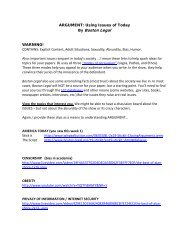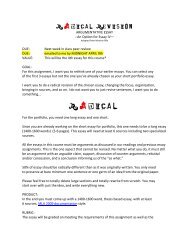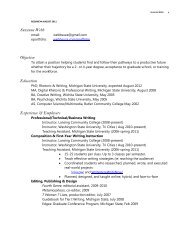4 Things 50 Cent Can Teach You About Audience
4 Things 50 Cent Can Teach You About Audience
4 Things 50 Cent Can Teach You About Audience
You also want an ePaper? Increase the reach of your titles
YUMPU automatically turns print PDFs into web optimized ePapers that Google loves.
Four <strong>Things</strong> <strong>50</strong> <strong>Cent</strong> <strong>Can</strong> <strong>Teach</strong> <strong>You</strong> <strong>About</strong> Connecting with <strong>You</strong>r <strong>Audience</strong>...http://www.copyblogger.com/robert-greene-<strong>50</strong>-cent/2 of 18 12/2/2009 11:38 AMKnow your environment from the inside outMost people think first of what they want to express or make, then find the audience for theiridea. <strong>You</strong> must work the opposite angle, thinking first of the public. <strong>You</strong> need to keep your focuson their changing needs, the trends that are washing through them. Beginning with their demand,you create the appropriate supply. Do not be afraid of people’s criticisms—without suchfeedback your work will be too personal and delusional. <strong>You</strong> must maintain as close arelationship to your environment as possible, getting an inside “feel” for what is happeningaround you. Never lose touch with your base.~ The <strong>50</strong>th LawAn experiment in reconnectionIn early 2007, Fifty decided to start up his own website. He thought of it as a way to market his music andmerchandise directly to the public, without the screen of his record label, which was proving quite inept inadapting to the Internet age.First, he decided to experiment. As he prepared to launch a G-Unit record in the summer of 2008, he leakedone of the songs on to the website on a Friday night, then the next day he refreshed the Comments page everyfew minutes and tracked the members’ response to it.After several hundred comments it was clear that the verdict was negative. The song was too soft. Theywanted and expected something harder from a G-Unit record.Taking their criticisms to heart, he shelved the song and soon released another, creating the hard sound theyhad demanded. This time the response was overwhelmingly positive.He put up the latest single from his arch-enemy The Game, hoping to read the negative comments of his fans.To his surprise, many of them liked the song. He engaged in an online debate with them about this and had hiseyes opened about changes in people’s tastes and why they had perhaps grown distant from his music. Itforced him to rethink his own direction.Creating a radical connectionTo draw more people to his site, Fifty decided to break down the distance in both directions. He posted blogson personal subjects, and then responded to his fans’ comments. They could feel they had complete access tohim.Using the advances in technology, he took this further, having his team film him on their cell phones whereverhe went; these images were then streamed live on the website. Made dramatic by Fifty’s flair forconfrontation, membership grew by leaps and bounds.As it evolved, the website came to strangely resemble the world of hustling that Fifty had created for himselfon the streets of southside Queens.He could produce testers (trial songs) for his fans, who were like drug fiends, constantly hungry for newproduct from Fifty; and he could get instant feedback on their quality. He could develop a feel for what theywere looking for and how he could manipulate their demand.He had moved from the outside to the inside and the hustling game came alive once more, this time on aglobal scale.








